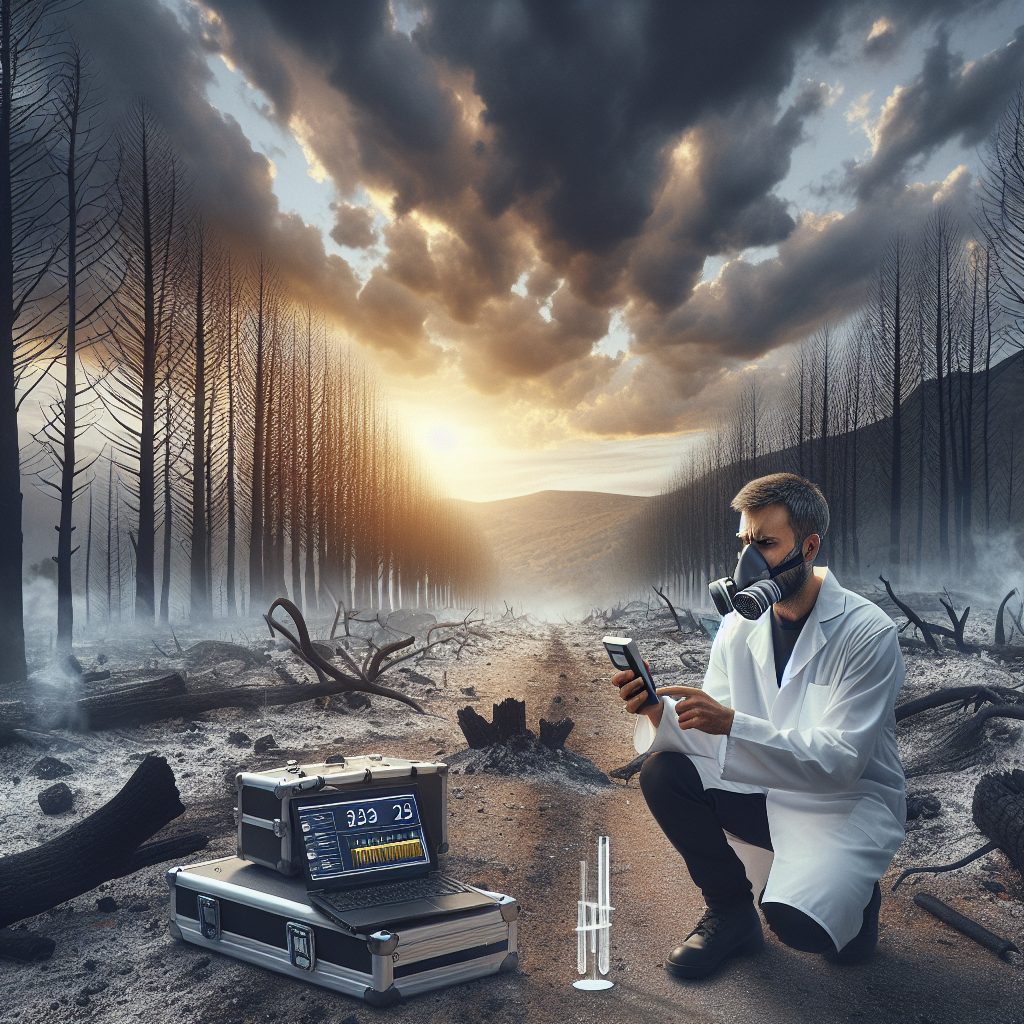
Are you concerned about the air quality in your home or workplace after a fire? It’s crucial to take immediate action to ensure the safety of yourself and others. In this article, we will guide you on how to test air quality after a fire, providing you with essential information and steps to follow. Discover the importance of air quality testing, learn how to identify potential hazards, and find out how to effectively clean and restore your indoor environment. Don’t compromise on your health and well-being – read on to learn how to ensure the air you breathe is safe and clean.
Important Highlights
1. **Understand the potential health risks:** After a fire, it is crucial to be aware of the health risks associated with poor air quality, such as respiratory issues and exposure to harmful substances like carbon monoxide. Monitoring air quality can help prevent further health complications.
2. **Assess the indoor environment:** Test the air quality indoors, paying close attention to the presence of smoke particles, volatile organic compounds (VOCs), and other pollutants. Use air quality monitors to measure these levels accurately.
3. **Evaluate the outdoor air:** Monitor the outdoor air quality as well, as it can greatly impact the indoor environment. Keep an eye on local air quality reports and use portable air quality monitors to determine if it is safe to open windows or spend time outside.
4. **Consider professional air testing:** If you suspect significant contamination or are unsure about the air quality, it is advisable to hire professionals who specialize in post-fire air testing. They can conduct comprehensive assessments and provide detailed reports on the presence of hazardous substances.
5. **Take action to improve air quality:** If air quality tests reveal concerning levels of pollutants, take steps to improve the indoor environment. This may include using air purifiers, properly ventilating the space, cleaning surfaces, and replacing air filters regularly. Regularly retest the air quality to ensure progress is being made.
Why Testing Air Quality After a Fire is Important
Testing air quality after a fire is crucial to ensure the safety and well-being of individuals in the affected area. Fires release various harmful pollutants into the air, including smoke, soot, and toxic gases. These pollutants can have severe health effects, especially for those with respiratory conditions or weakened immune systems. By testing the air quality, you can determine the level of contamination and take appropriate measures to protect yourself and others.
When to Test Air Quality After a Fire
It is essential to test air quality as soon as it is safe to do so after a fire. The aftermath of a fire can leave behind lingering pollutants that continue to pose health risks. Therefore, it is recommended to test the air quality within the first few days after the fire. However, if the fire occurred indoors, it is crucial to wait until the area has been adequately ventilated and cleaned before conducting the test.
Methods for Testing Air Quality After a Fire
There are several methods available to test air quality after a fire:
1. Visual Inspection
Begin by visually inspecting the affected area. Look for visible signs of soot, smoke residue, or mold growth. These indicators can give you a general idea of the extent of contamination.
2. Odor Assessment
Pay attention to any lingering odors in the air. Smoke and other pollutants can leave behind a distinct smell. If you notice a strong, unpleasant odor, it may indicate the presence of harmful substances in the air.
3. Air Sampling
Air sampling involves collecting air samples and sending them to a laboratory for analysis. There are different types of air sampling methods, including grab sampling and continuous monitoring. These tests can provide detailed information about the presence and concentration of specific pollutants.
4. Particulate Matter Monitoring
Particulate matter monitoring involves measuring the levels of fine particles in the air. These particles can be released during a fire and can have adverse health effects when inhaled. Monitoring particulate matter can help assess the overall air quality and potential risks.
Interpreting Air Quality Test Results
Once you receive the results from the air quality tests, it is essential to interpret them correctly. The laboratory report will provide information about the presence and concentration of various pollutants. Compare the results to the recommended air quality standards or guidelines provided by health organizations or local authorities. If the levels exceed the acceptable limits, take immediate action to mitigate the risks.
Actions to Take Based on Test Results
Depending on the test results, there are several actions you can take to improve air quality and ensure safety:
1. Ventilation
Ensure proper ventilation in the affected area. Open windows and doors to allow fresh air to circulate and remove any lingering pollutants.
2. Air Purification
Consider using air purifiers with high-efficiency particulate air (HEPA) filters to remove contaminants from the air. These filters can capture fine particles and improve overall air quality.
3. Cleaning and Restoration
Thoroughly clean and sanitize surfaces to remove any soot or smoke residue. This includes carpets, furniture, walls, and other affected areas. If necessary, consult professionals for specialized cleaning and restoration services.
4. Seek Professional Help
If the air quality test results indicate high levels of pollutants or if you are unsure about the appropriate actions to take, it is advisable to seek professional help. Environmental consultants or restoration experts can provide guidance and assistance in addressing air quality concerns.
Conclusion
Testing air quality after a fire is essential for safeguarding the health and well-being of individuals in the affected area. By following the appropriate testing methods and interpreting the results correctly, you can take necessary actions to improve air quality and mitigate potential risks. Remember, timely testing and appropriate measures are key to ensuring a safe and healthy environment after a fire.
5 Tips for Testing Air Quality After a Fire
- Perform a visual inspection to identify visible signs of contamination.
- Pay attention to any lingering odors, as they may indicate the presence of harmful substances.
- Consider air sampling and particulate matter monitoring for a comprehensive assessment.
- Interpret the test results by comparing them to recommended air quality standards.
- Take appropriate actions based on the results, such as ventilation, air purification, cleaning, and seeking professional help if needed.

Frequently Asked Questions
1. How do I test air quality after a fire?
To test air quality after a fire, you can use air quality monitors or hire a professional testing service. These monitors measure various pollutants and particulate matter in the air, giving you an indication of the air quality in your surroundings.
2. What are the common pollutants found in the air after a fire?
Common pollutants found in the air after a fire include carbon monoxide, volatile organic compounds (VOCs), particulate matter (PM2.5 and PM10), and hazardous gases. These pollutants can have detrimental effects on human health if inhaled.
3. Can I use DIY methods to test air quality after a fire?
While there are DIY methods available to test air quality after a fire, it is recommended to seek professional help. Professional testing services have specialized equipment and expertise to accurately assess the air quality and identify potential risks.
4. How long should I wait to test air quality after a fire?
It is advisable to wait for at least 24 to 48 hours after a fire before testing the air quality. This allows time for the pollutants to disperse and for the environment to stabilize. Testing too soon after a fire may not provide accurate results.
5. What are the potential health risks of poor air quality after a fire?
Poor air quality after a fire can lead to various health issues, including respiratory problems, eye irritation, headaches, dizziness, and exacerbation of existing conditions such as asthma or allergies. It is crucial to ensure the air quality is safe before returning to the affected area.
6. Can I rely on visual cues to determine air quality after a fire?
Visual cues can provide some indication of air quality after a fire, such as smoke or soot particles in the air. However, they do not provide a comprehensive assessment of the presence of harmful pollutants. It is best to use professional testing methods for accurate results.
7. Are there any specific areas or items I should test for air quality after a fire?
Apart from testing the overall air quality, it is essential to focus on specific areas or items that may have been directly affected by the fire, such as carpets, furniture, and ventilation systems. These areas can harbor pollutants and contribute to poor air quality.
8. How can I improve air quality after a fire?
To improve air quality after a fire, you can ensure proper ventilation by opening windows and using fans. Cleaning and removing any visible soot or debris can also help. Additionally, using air purifiers with HEPA filters can effectively remove fine particles and improve indoor air quality.
9. Are there any long-term effects of exposure to poor air quality after a fire?
Exposure to poor air quality after a fire can have long-term effects on respiratory health, especially if the exposure is prolonged or repeated. It is crucial to take necessary measures to mitigate the risks and ensure a safe living environment.
10. When should I seek professional help for testing air quality after a fire?
You should seek professional help for testing air quality after a fire if you notice persistent respiratory symptoms, strong odors, or if you have concerns about the safety of the environment. Professional testing can provide accurate results and guidance for remediation.
Final Thoughts
Testing air quality after a fire is crucial to safeguarding your health and well-being. The aftermath of a fire can introduce various pollutants into the air, posing risks to both immediate and long-term health. By using professional testing services or reliable air quality monitors, you can gain valuable insights into the presence of harmful substances and take appropriate measures to ensure a safe living environment.
Remember, visual cues alone are not sufficient indicators of air quality, as harmful pollutants may not always be visible. Prioritize your health by seeking professional assistance, addressing specific areas of concern, and implementing measures to improve air quality. By doing so, you can restore a healthy and safe environment after a fire incident.



